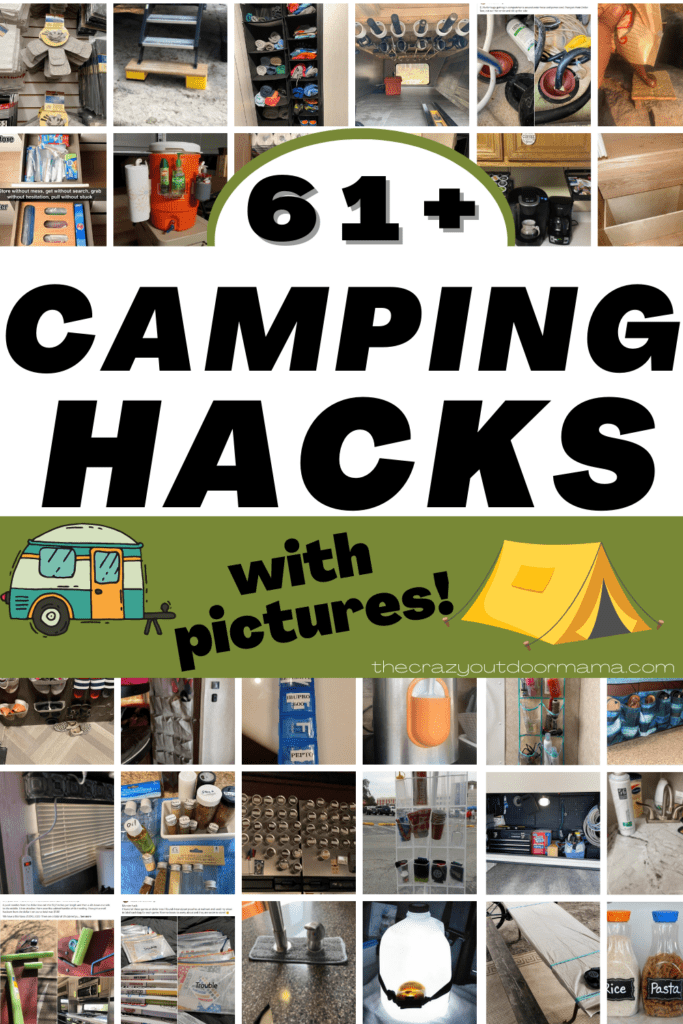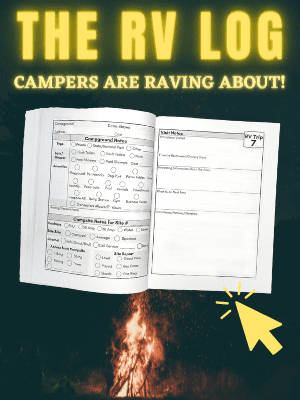Few things can put a damper on your camping trip quite like a wet tent. Whether it’s a sudden rainstorm or morning dew, a poorly waterproofed tent can lead to a soggy and uncomfortable night’s sleep. Plus it could even damage your gear.
That’s why understanding how to properly waterproof your tent is a skill every camper should master.
So in this 10-minute read, let’s look at the art of waterproofing a tent. We’ll cover…
- Choosing the right waterproofing method
- Step-by-step instructions
- Tips for campsite setup that help your tent stay dry
- In another article, we’ll cover more tips for tent camping in the rain.
Let’s start with getting to know your tent.
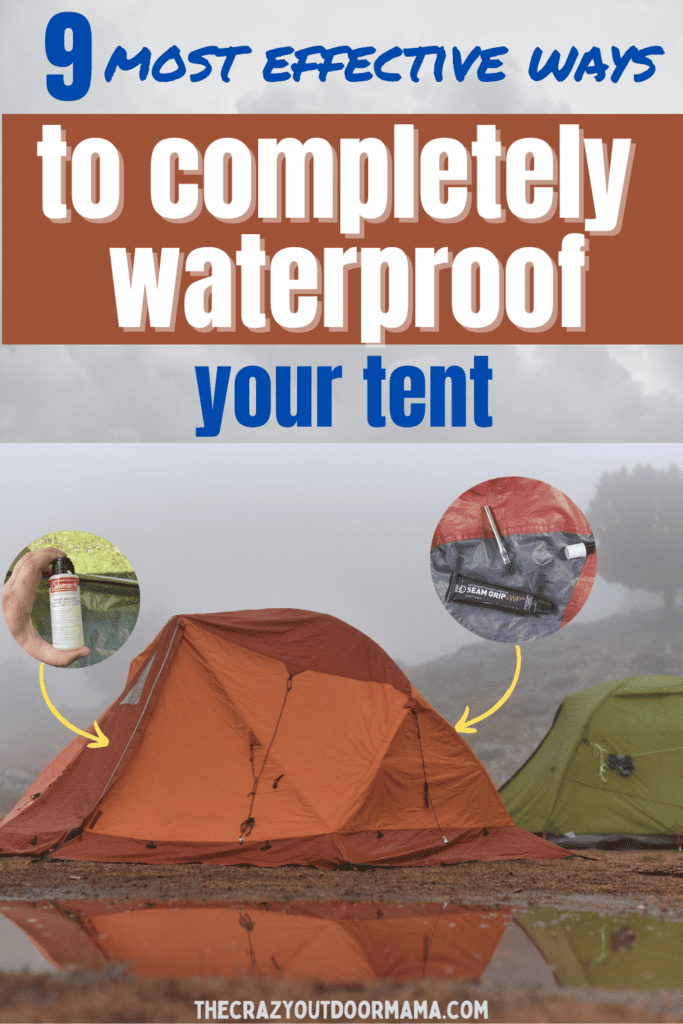
Table of Contents
Know Your Tent
A key step in waterproofing your tent is understanding its construction and materials. Different tent materials have varying degrees of waterproofness, and knowing the characteristics of your tent will help you choose the most effective waterproofing method.
TIP! – If you don’t know all your tent’s specs off the top of your head, it’ll help to get them now. Look your tent up online or get the papers that came with it and look them over as you go through this next section.
Tent Materials and How They Affect Waterproofing
Tents are typically made from materials such as nylon, polyester, or canvas. Each has its advantages and disadvantages when it comes to waterproofing.
Nylon is a popular choice since it is lightweight and durable. It’s usually found on upper mid-range and high-end tents.
Nylon has an impressive strength-to-weight ratio, excellent abrasion resistance, and affordability. Its elasticity allows stress to be evenly distributed over larger areas. This improves durability, particularly at stress points like guy lines on a tent.
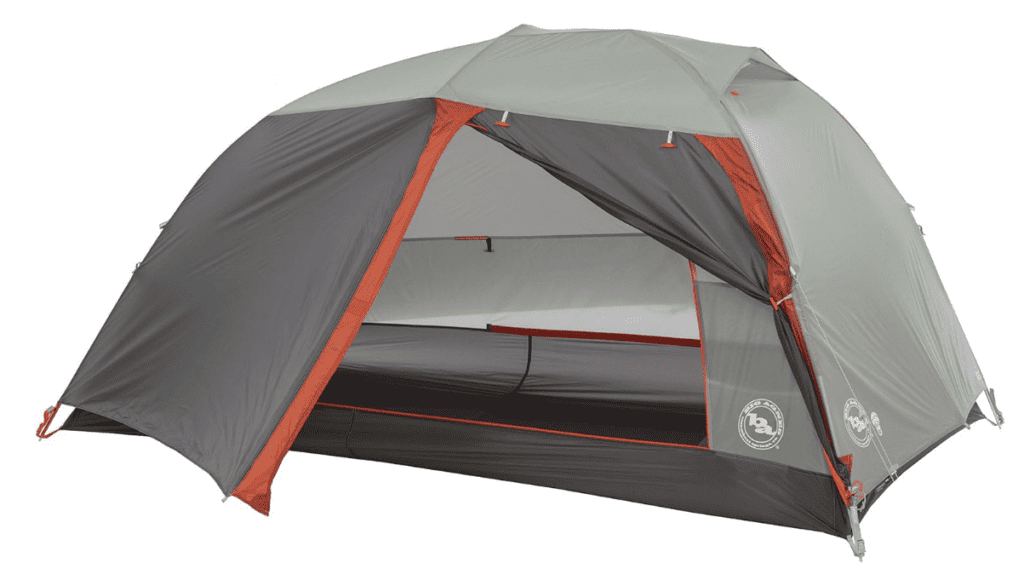
Nylon does have some drawbacks. It is vulnerable to UV degradation. While there are treatments to mitigate this, UV damage often determines the lifespan of a nylon tent. Also, nylon’s tendency to absorb water can lead to a heavier tent that sags in wet conditions. That means you might need to re-tension your rain fly from time to time while it’s raining.
But there are ways to mitigate those drawbacks. Tents that use a nylon fabric normally have some type of UV-resistant waterproof coating which you need to reapply from time to time.
Example of a nylon tent: Big Agnes Copper Spur HV UL – Ultralight Backpacking Tent
Polyester, once confined to lower-end camping gear due to its poor strength-to-weight ratio, is undergoing a resurgence in the tent market. Recent developments in high-quality, lightweight polyester fabrics have narrowed the gap with nylon, making polyester a better option for low to mid-range tents.
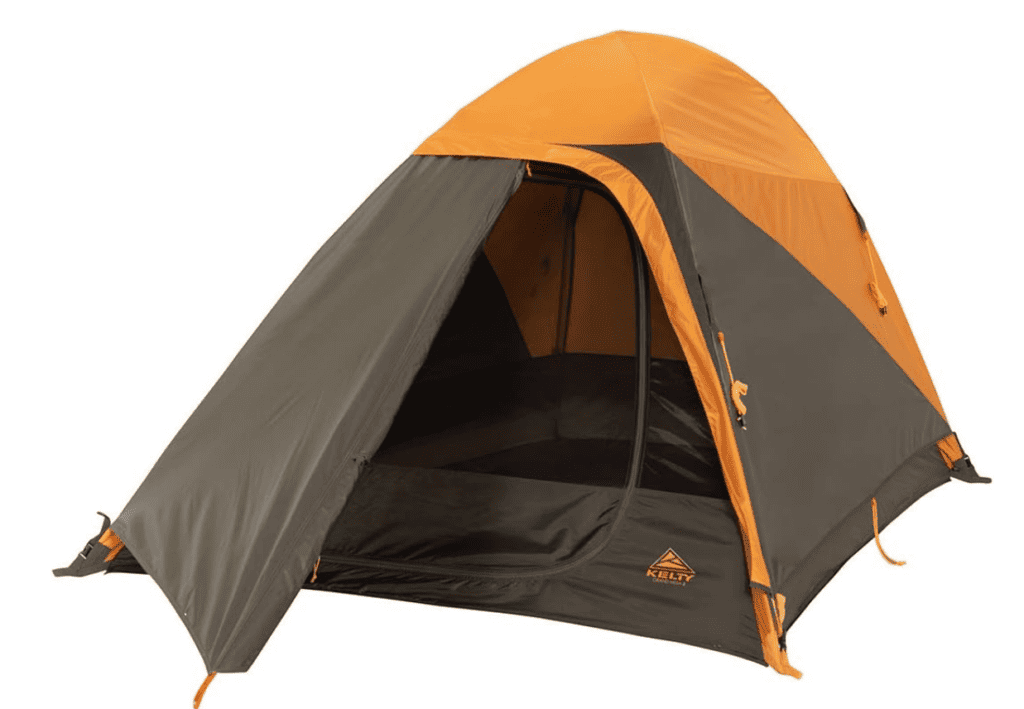
Polyester also absorbs less water and retains tension better than nylon, offering a slight advantage in wet environments.
Example of a polyester tent: Kelty Grand Mesa Backpacking Tent
Dyneema Composite Fabric (DCF), formerly known as Cuben Fiber, is a newcomer in tent materials. DCF is used in ultralight tents because of its high strength-to-weight ratio. It is also waterproof without the need for additional coatings.
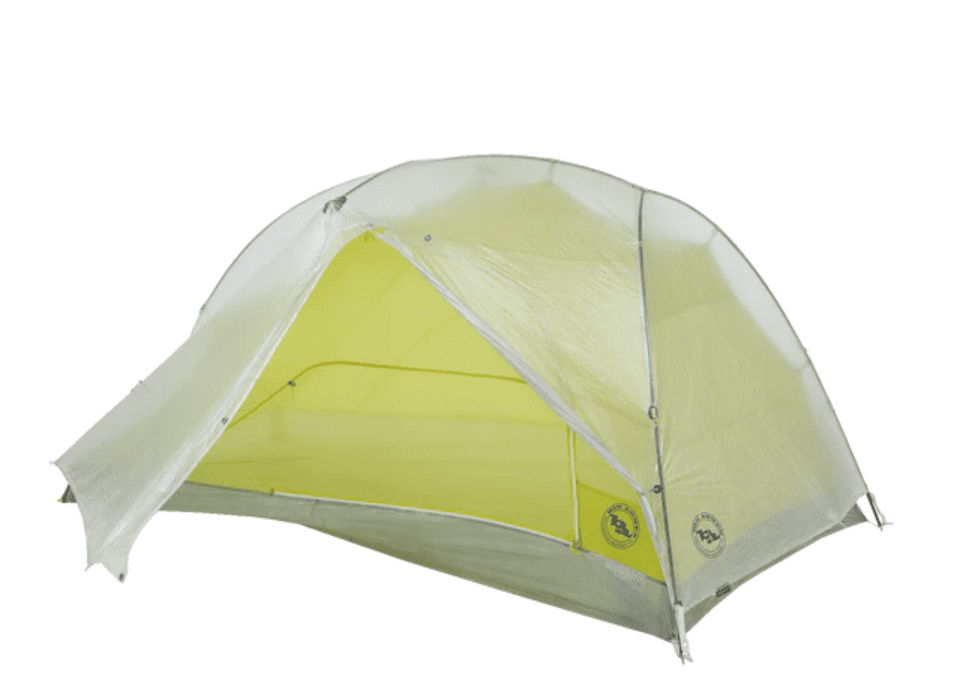
However, despite its advantages, DCF is considerably more expensive and less abrasion-resistant than other fabrics, limiting its use to niche applications within the ultralight backpacking community.
Example of a DCF fabric tent: Big Agnes Tiger Wall 2 Carbon
Canvas tents aren’t used much anymore, but hey…you still might have Grandpa’s old canvas wall tent you want to get out of storage. Or may you want to take advantage of a canvas tent’s durability and leave one set up at a camp for longer periods.
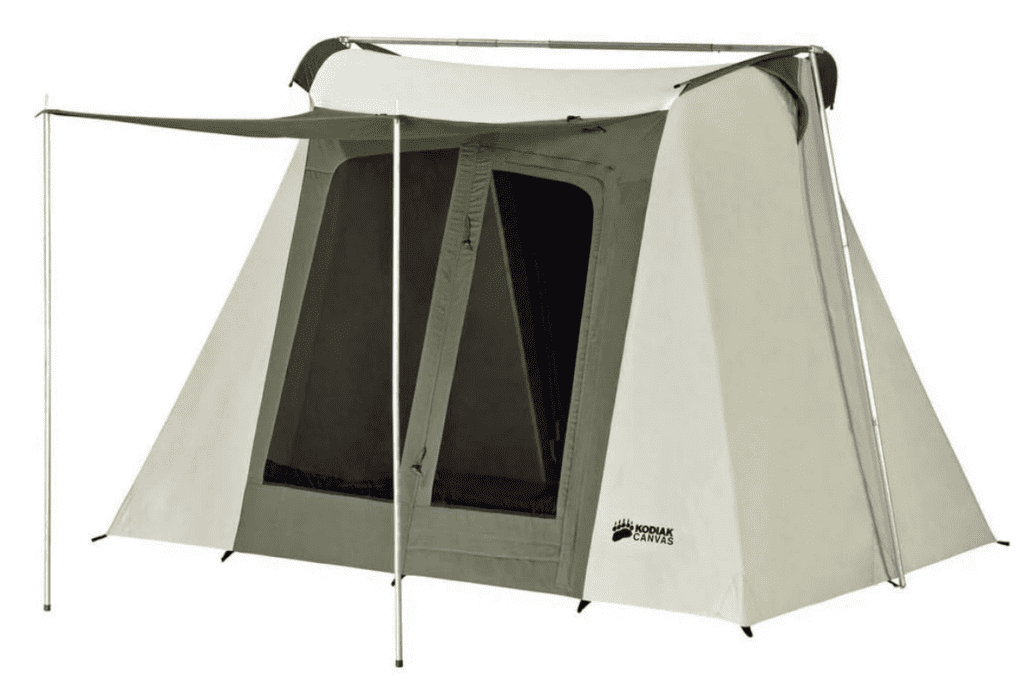
Canvas naturally provides better insulation and breathability than nylon and polyester. However it requires regular waterproofing maintenance because it is not inherently waterproof.
Canvas tent example: Kodiak Canvas Flex-Bow Canvas Tent
Waterproofing Methods
So how do modern tent designs achieve their water resistance? Here are 3 main ways.
- Most modern tent fabrics — nylon and polyester — will have some kind of water-resistant coating applied to the outside. Some are silicone-based and some are based on other chemical combinations. Keep in mind that if your tent or part of it uses a silicone-type waterproofer, it’s best to use a silicone waterproofing spray when reapplying.
- Some parts of the tent — such as the rain fly and tent floor will also have a PU (polyurethane) coating on the underside to provide additional moisture protection. Instead of penetrating the fabric, this creates more of a surface layer of PU on one side of the fabric.
- Many tents also come with sealed seams (using tape or some kind of sealer adhesive).
Identifying the Weak Spots and Areas Prone to Leaks
Before applying any waterproofing treatments, it’s crucial to identify the weak spots and potential areas where leaks are more likely to occur in your tent. Common areas vulnerable to leaks include seams, zippers, and areas where the floor and walls meet.
- Tent seams are often stitched with thread, and these needle holes can let water seep through.
- Zippers are another potential weak spot in tent construction. They can let water in if not covered by a flap.
- Tent floors are a weak spot since they are in constant contact with the ground.
Additionally, the area and seams where the tent’s floor meets the walls are susceptible to leaks, especially if water pools or collects around the perimeter.
By familiarizing yourself with the material of your tent and taking note of potential weak spots, you’ll be well-prepared to tackle the next steps in waterproofing your tent effectively.
Choosing Your Waterproofing Method and Product
When it comes to waterproofing your tent, there are several ways to waterproof trouble areas of your tent. And there are specific products for each.
Seam Sealing
Seam sealing is an effective method to prevent leaks in these areas. Seam sealer products create a waterproof barrier along the seams, keeping water out and protecting your tent from moisture.
Some tents come with the seams already sealed. In this case, you only have to seal the seams if the existing sealant or tape starts to degrade.
Pros:
- Targeted waterproofing: Seam sealers focus on sealing the needle holes in tent seams, providing a reliable waterproof barrier.
- Durable and long-lasting: Once applied, seam sealers can provide long-lasting protection against leaks and moisture.
- Compatible with various materials: Seam sealers can be used on most tent fabrics, including nylon, polyester, and canvas.
Cons:
- Requires attention to detail: Properly sealing the seams requires precision and careful application to ensure complete coverage.
- Additional time and effort: Seam sealing can be a time-consuming process, especially for larger tents with numerous seams.
Recommended Products for Seam Sealing:
GEAR AID Seam Grip WP Waterproof Sealant and Adhesive
This is the seam sealer to get for most tents. If you’re sealing seams on tents (or areas of the tent) with a silicone-based waterproofing treatment, go with the next option.
- Treats up to 12’ of seams or repairs torn fabrics with a flexible rubber seal using a 1 oz tube.
- Waterproofs and bonds to nylon, polyester, canvas, leather, and vinyl.
- Includes two applicator brushes for easy application without peeling or cracking.
- Seals up to 24 feet of seams on silicone-treated gear with 1.5 oz of permanent, clear adhesive.
- Suitable for ultra-light gear
- Forms a durable, weather-resistant seal that withstands extreme temperatures.
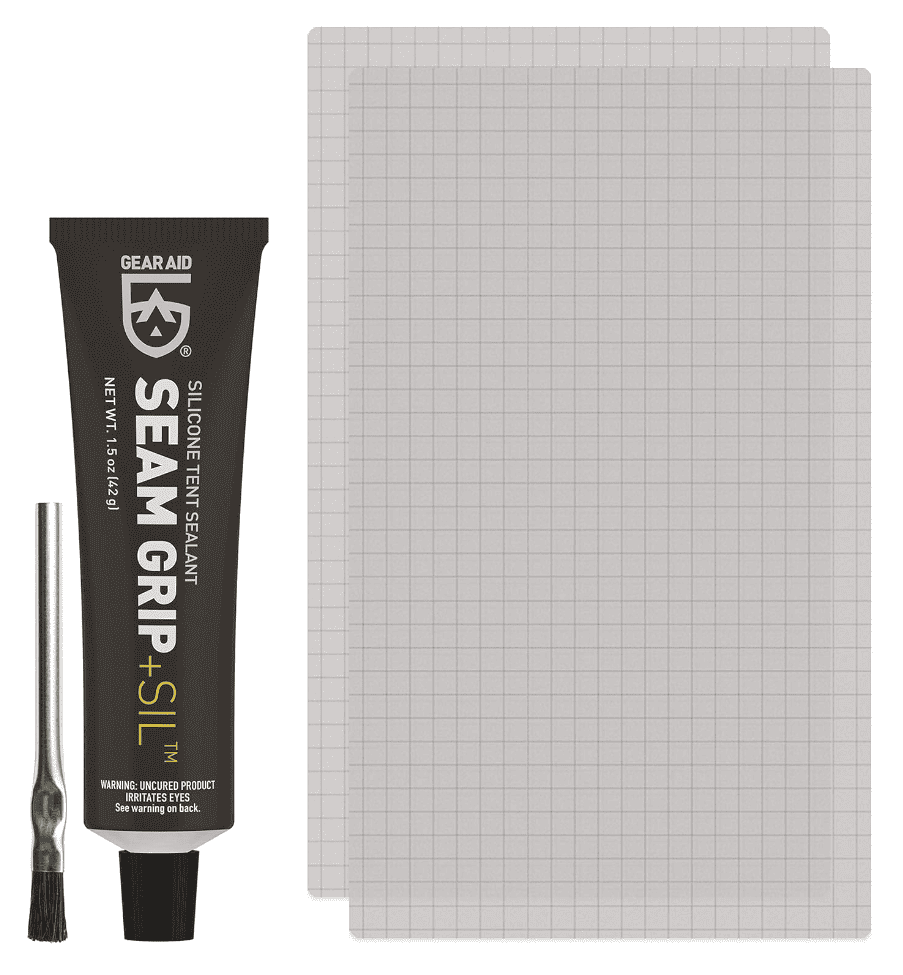
Coghlans Water Based Seam Seal – Cheapest Option
- Waterproofs seams on synthetic fabrics
- Suitable for outdoor gear like tents, tarps, rain gear and backpacks.
- Flexible, and survives washing.
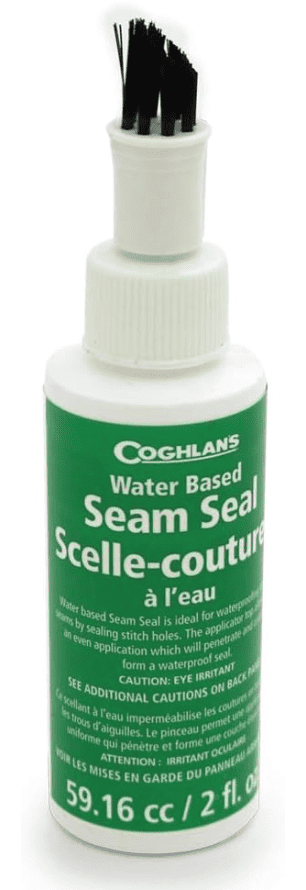
- Seal the seams on common outdoor gear.
- Comes in a 2-oz. bottle with a foam applicator pad for easy use.
- Fast-drying, water-based urethane formula; no mixing needed.
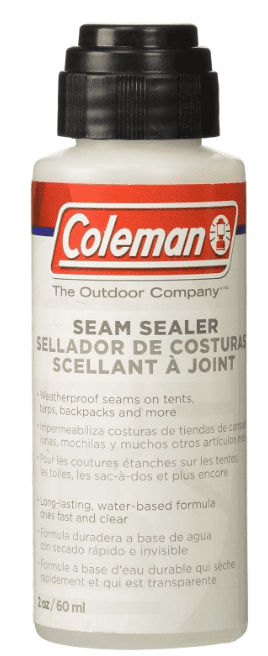
How to Apply Seam Sealer
You’ll need:
- A clean cloth
- Rubbing alcohol
- The appropriate seam sealer and applicator
Sealing the seams is pretty straightforward:
- Pitch your tent in an area that’s both dry and well-lit.
- You’ll focus on sealing the seams on the underside of the rainfly and from the interior side of the tent body.
- Drape the rainfly over the tent inside out.
- Remove any loose sections of existing seam tape or sealer.
- Lightly clean the seams with a cloth dabbed in rubbing alcohol.
- Carefully apply the seam sealer along the seams using the applicator (usually a brush or foam pad) provided with the product.
- Let the seam sealer dry completely before packing the tent away.
Expert tip – Don’t just seal the sections where the old tape has peeled off. If it’s already started peeling off in some sections, it’s just a matter of time before it does it everywhere. So while you have your sealer out, you might as well do them all.
Waterproofing Spray (DWR)
With repeated use, UV exposure and cleaning, the durable water-repellent (DWR) coating can become less effective.
How do you know if that’s the case with your tent?
When your tent fabric gets wet, does the water still bead up on it? No? Then it’s time to refresh the DWR. Using a waterproofing spray is a popular and convenient method for waterproofing your tent.
Pros:
- Easy to apply: Waterproofing sprays are typically user-friendly, requiring minimal effort and time to apply.
- Versatile: Can be used on various tent materials, including nylon, polyester, and canvas.
- Provides a protective layer: Waterproofing sprays form a barrier on the fabric, enhancing its water-resistant properties.
Cons:
- Limited lifespan: The effectiveness of waterproofing sprays may diminish over time, requiring reapplication.
- May affect breathability: Depending on the brand and application method, some sprays can reduce the breathability of the tent material.
Recommended Products for Waterproofing Spray:
Nikwax Tent & Gear Care – Provides Best Protection
- Tent & Gear SolarWash and SolarProof offers a two-step cleaning and waterproofing solution for outdoor gear.
- SolarWash ensures effective cleaning that preserves water repellency and boosts fabric strength with UV protection.
- SolarProof enhances water resistance, increases the durability of fabrics, and provides UV shielding to prevent degradation.
- The products feature a spray-on, foaming application, are environmentally friendly with water-based, PFAS-free formulas. They are suitable for a range of items including tents, backpacks, and patio furniture.
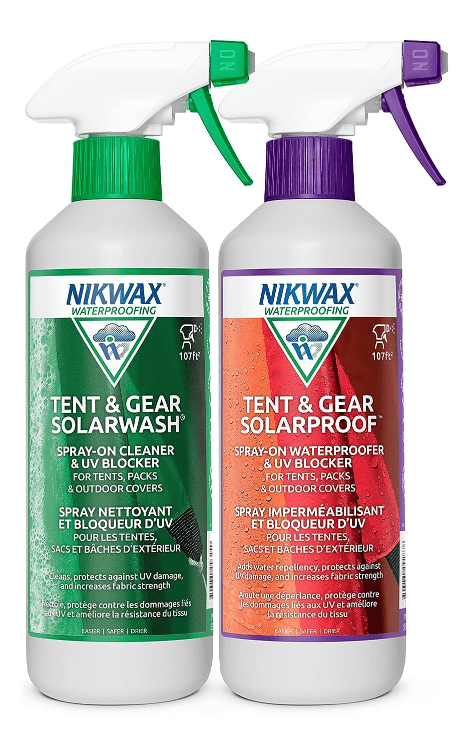
Gear AID Revivex Durable Water Repellent (DWR) Spray
- Restores water repellency to GORE-TEX garments, nylon gear, and outdoor wear.
- A 16oz spray can waterproof a small 2-person tent.
- Maximizes breathability of waterproof fabrics.
- Easy application with trigger sprayer
*There’s a nice chart on their product description that shows how much of this spray you’ll need for different items.
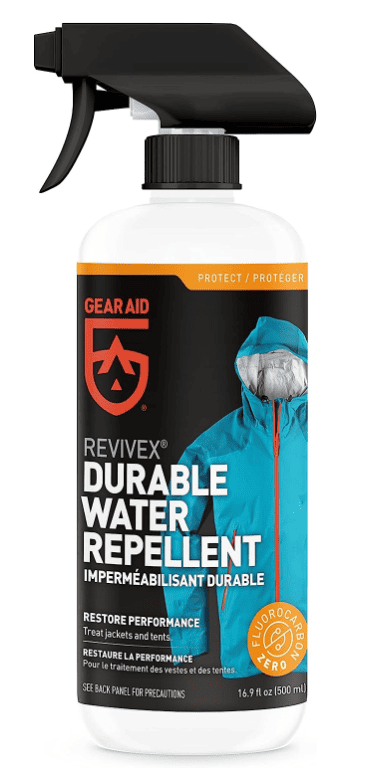
Scotchgard Outdoor Water Shield
- Scotchgard Outdoor Water Shield Spray (13 oz) offers water repellency for a variety of outdoor fabrics.
- Suitable for tents, outerwear, gear, and more, and safe on materials like polyester, nylon, and leather.
- Maintains fabric breathability and dries odorless.
- Recommended for seasonal reapplication, covering 75 sq ft on light nylon or 25 sq ft on heavier fabrics.
Sof Sole Silicone Waterproofer Spray
*This is especially good if you are refreshing a tent that has already been treated with silicone.
- 12% silicone formula ensures a durable waterproof bond that resists water, dirt, and oil.
- Convenient application with aerosol spray can.
- Suitable for hiking/work boots, tents, and outdoor gear.
- Not for breathable technical fibers like Gore-Tex or athletic shoes, as it may alter color and reduce functionality.
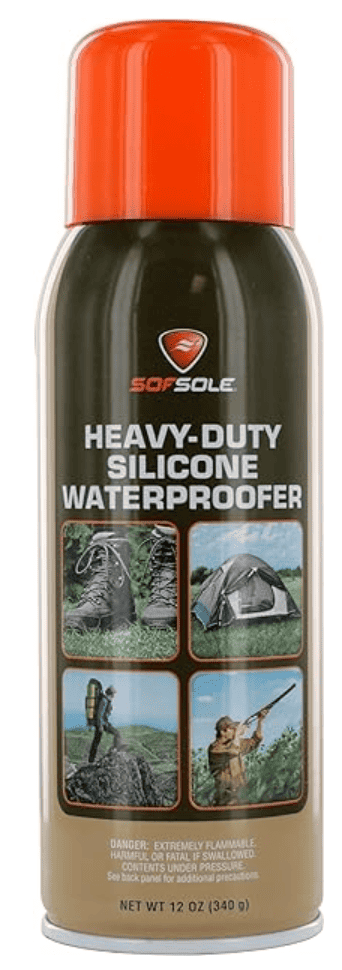
- Silicone-based product suitable for a wide range of outdoor items including tents, tarps, boots, and patio furniture.
- Odorless after drying and maintains the breathable quality of the treated material.
- Bonds with leather and fabric to form a robust water barrier.
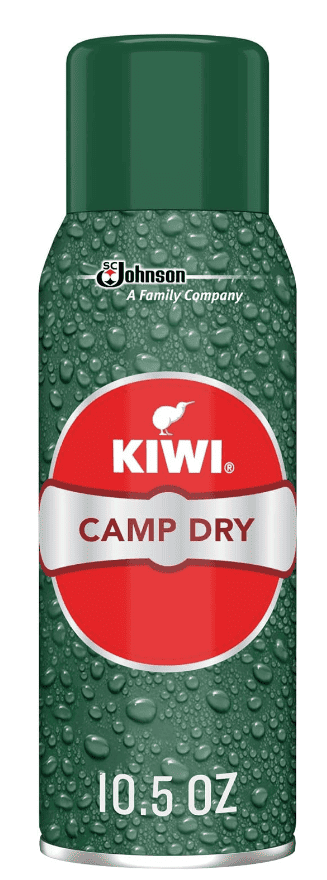
How to Waterproof a Tent With Waterproofing Spray
You’ll need:
- Spray-on water-repellent treatment.
- Clean cloth
- A way to spray your tent down with clean water.
Application steps:
- Set up your tent
- Spray it down with water
- Spray the DWR product uniformly across the fabric surface. With most products, you don’t need to let the fabric dry. Be sure to read the instructions on the product you purchase.
- Wait a few minutes. Then use the damp cloth to remove any extra.
- Allow the tent to air dry fully before storing.
Waterproof PU Coating
The rainfly and tent floor often have a polyurethane (PU) coating on one side. With time, that coating can start to flake off and will reduce the fabric’s waterproofness. Fortunately, there’s a product that can help refresh this coating.
GEAR AID Seam Grip TF Tent Fabric Sealer for Waterproofing
Keep in mind, this is not something you spray all over your tent. You would likely only use this on the underside of your rainfly or tent floor.
- Waterproof up to 85 sq. ft. of nylon tent floors and tarps with a 4 fl oz bottle of tent sealer.
- Revitalize aging polyurethane (PU) coatings that are peeling or deteriorating.
- Dries to a flexible, nearly invisible coating that moves with the nylon material.
Follow the instructions for application. It’s pretty straightforward – after cleaning, rub this product on the fabric using the foam applicator head.

Proper Maintenance for Prolonging the Waterproof Coating
Proper maintenance is critical for extending the life of your tent and maintaining its waterproofing qualities.
- After each trip, shake out your tent and let it dry before storing it.
- From time to time, use mild soap and some water to give it a more thorough cleaning. Avoid harsh chemicals or abrasive cleaning pads that could damage the waterproof coating.
- Minimize your tent’s exposure to harmful UV rays by camping in shaded areas or using a rainfly, and always inspect and repair any damage with appropriate materials.
- When storing, completely dry your tent to prevent mold and mildew. And choose a cool, dry place away from direct sunlight and extreme temperatures for storage.
Tips for Campsite Setup So Your Tent Stays Dry
Thin nylon and polyester fabrics with water-resistant coatings can only do so much. If you park your tent in a bowl, don’t secure the rainfly and it downpours…you’re gonna get wet.
So keep these things in mind while setting up your site.
- Choosing where to place your tent: Opt for higher ground to avoid standing water and look for natural barriers for wind and water protection. Steer clear of valleys or depressions where water may collect.
- Using a Footprint: Lay down a tent footprint to shield your tent floor from moisture and damage. The footprint should be smaller than the tent’s base and fully covered by the tent to avoid water accumulation. Use a normal tarp or get a footprint made specially for your tent.
- Rainfly Setup: Install a rainfly over your tent for extra rain protection, making sure it’s well-aligned and taut to prevent water from pooling.
- Extra Measures: Use tarps for additional coverage as needed. Sometimes you may have to dig a small trench around part of your tent to help redirect water runoff.
Say NO! To Soggy Sleeping Bags
That’s right…a downpour doesn’t have to mean soggy sleeping bags. Keep your tent as dry as possible on the inside by…
- Periodically applying a waterproof coating
- Keeping the seams sealed
- Setting it up properly and in the right location
Want some more tips to make the most out of your next tent camping trip? Check out these articles!
- 47 Tent Camping Set Ups You’ll LOVE (With Pics!)
- Camping in Cold Weather: Expert Tips for Tent Camping
- Expert Tips for Tent Camping in the Rain – COMING SOON
- 4H Archery Worksheets for Kids – Parts of a Compound Bow + More! - June 30, 2024
- 4H Archery Project Idea + Fun Archery Practice Ideas! - June 30, 2024
- DIY Nerf Orc Targets – Perfect for a Nerf Themed Party! - June 15, 2024

